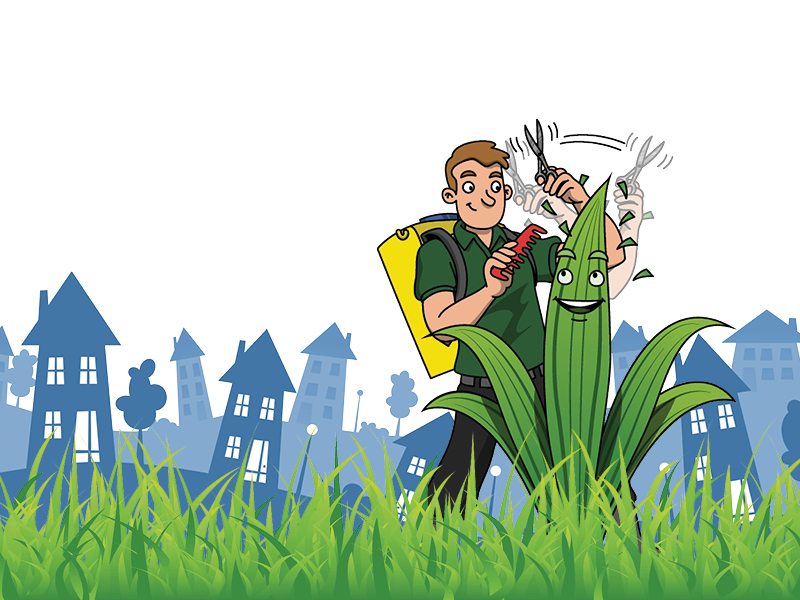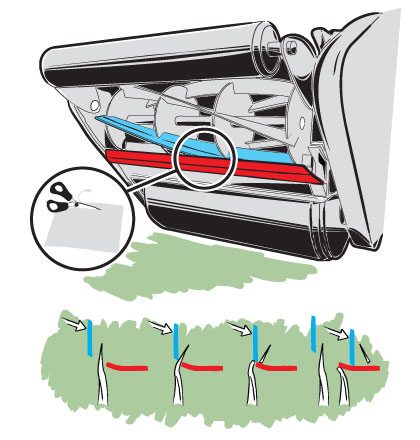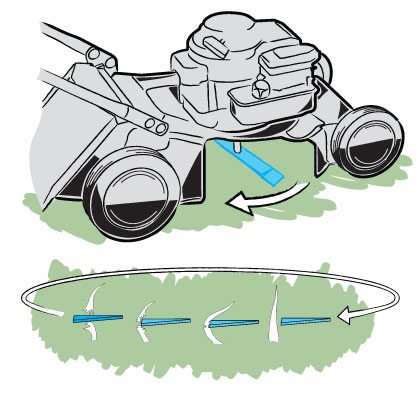

Mowing your lawn correctly can mean the difference between a good lawn and a great lawn. By following these simple rules, you will gain more benefit from your Tom Thumb Lawn Care treatments, leading to a healthier looking lawn:
Most plants behave in the same way when they are cut. For example, if you have ever cut the top off a tomato plant, you will find that the energy is sent to the lower part of the plant, leading to it thickening up at the base.
Lawn Mower Type
There are two types of lawn mower available. Cylinder Lawn Mower and Rotary Lawn mower.
Cylinder Mower
A cylinder mower works like a pair of scissors and has a fixed cutting blade at the front of the mower and a set of cylindrical blades that turns. As the cylinder turns, it cuts the grass blades against the fixed cutting blade. There is usually a box at the front of the mower where the grass clippings are deposited.


Rotary Mower
Rotary mowers are the most common lawn mower nowadays. The blade spins around at high velocity and slices the grass plant as it turns. Rotary mowers also create a vacuum effect which pulls the grass plant towards the blade and deposits the clippings in to a collection basket.
Both types of mower are very effective. However, due to the spinning rotary blade, rotary mowers are a lot more powerful, and therefore more suitable for a domestic lawn. Cylinder mowers (or Reel Mowers) can create a beautiful lawn and give a better cut, but to gain the benefit from a cylinder mower, you must cut your lawn more regularly and cut a smaller amount of grass off the tip. Rotary mowers are also better on lawns that are lumpy and bumpy, and can handle longer grass.


When To Cut Your Lawn
There is no right and wrong time of year to cut your lawn. If your lawn needs cutting, cut it. Your lawn will grow most actively during the spring and towards the end of the summer. Mild winters can cause your lawn to continue growing throughout the autumn and winter period. If cutting during wet periods of the year, make sure the lawn is sufficiently dry enough before attempting to cut it. The ground should not be saturated and the leaves of the grass plants should not have water droplets on them.
When Not To Cut Your Lawn
During periods of wet weather, your lawn may grow quicker than usual. It can therefore be difficult to know when to cut. Modern lawn mowers should be able to cope with damp grass as long as you make sure the blade is sharp and you don’t push the lawn mower too quickly. Make sure you give the lawn a sufficient amount of time to dry off before cutting.
Don’t be tempted to cut your lawn during the midday sun. This can dehydrate the grass plant and you may end up with a brown lawn! Don’t cut your lawn during periods of drought either as this will only prolong the recovery period.
How Frequent Should I Cut My Lawn?
How often you cut your lawn depends on the height at which you want your lawn to be (see below). The frequency also depends on other factors such as weather conditions. During periods of warm and wet weather, your lawn will grow quicker, whereas during periods of cold OR dry weather, your lawn will grow slower.
The best way to determine when to cut your lawn is using the ‘one third rule’. This rule states that you should never cut more than a third of the grass plant off at each cut.
What Height Should I Cut My Lawn?
The height at which you cut your lawn, combined with the frequency you cut your lawn, will make the biggest difference to the condition of your overall lawn.
Just like most other plants, the grass plant likes to have a small amount taken off the top. By taking less than a third of the total height of the plant off, it will encourage the grass plant to thicken up from the base, thus thickening the plant up.
The key to a good cut is consistency. You should choose your cutting height and try to stick to it. Bearing in mind the ‘one third rule’ (see above), the height you choose should be based on the frequency with which you cut your lawn.
For example, if you want a short lawn (i.e. around 1/2 inch), you will need to cut your lawn more frequently (during normal weather conditions around every 2 to 5 days). If you only have time to cut your lawn once every 7 to 10 days, then you should aim to cut your lawn around 2 inches.
Keep Your Lawn Mower’s Blade Sharp
Lawn mower blades have been developed to cleanly slice the top of the grass blade off. This allows the tip to close over or heal quicker. If your mower blade is blunt, this will rip the top of the blade off, exposing the bare fibres of the grass. This will mean it takes longer for the plant to heal. The grass plant stores water in its leaves, so exposing these fibres causes the moisture to escape.
Don’t Push Too Fast
Pushing your lawn mower too quickly can cause the blade to tear the top off the grass plant rather than slicing it. Pushing it too quickly can also mean the mower does not collect all the clippings which can lead to thatch build up, or clumps of grass laying on the surface and killing small areas of your lawn.
Don’t Refill The Petrol Tank On Your Lawn
If you are using a petrol driven lawn mower, don’t be tempted to refill the fuel tank while the lawn mower is on the lawn. Petrol burns grass quickly and in most cases will kill whatever plants it touches.
Keep Your Lawn Mower Serviced
A lot of research has gone into developing modern lawn mowers. Keeping it serviced and clean is the best way to ensure your lawn mower works effectively.
